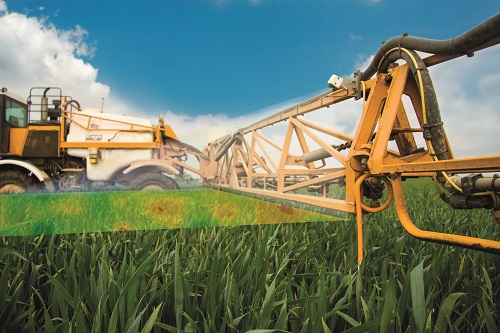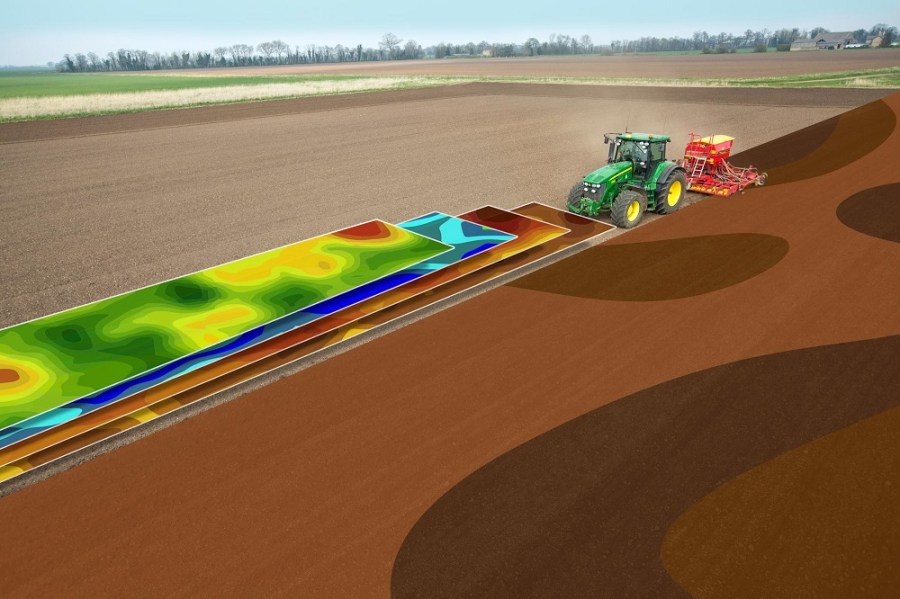Making use of data available to farm businesses is not just down to bringing it into a platform, but providing an interface that allows profitability pointers to stand out. In the second of our series on data management pioneers, CPM explores Hutchinsons’ Omnia.
We realised we needed to create a system to provide clients with the ability to take account of multiple layers of data at the same time.
By Charlotte Cunningham
Farmers have long relied on trusted relationships with their agronomist to help drive crop performance. However, times are changing and the rise of technology is affecting the way in which we farm. So can technology enhance this partnership?

Data can be added from the field and visualised in layers, captured using a tablet or through a tractor-mounted sensor.
Hutchinsons believes it can, and delivers this through its revolutionary precision farming system – Omnia. Interpreting both existing and new information it’s claimed to give users – both growers and agronomists – practical and effective advice, based on the use of layered field data.
This layering technique means that all management aspects that relate to a variable input decision can be superimposed onto each other. When determining variable seed rates, for example, the influence of soil type, seedbed condition, weed pressure and slugs can all be considered together.
What’s more, users can import initial farm data to the Omnia software via a computer. But as it’s a cloud-based system, more information can be added while in the field using a tablet – a quick and easy way to add extra dimensions to the analysis.
Feeling of frustration
Omnia’s journey began in 2013 in response to a noticeable shortfall in precision farming, says Oliver Wood, precision technology manager at Hutchinsons. “There was a feeling of frustration that precision farming didn’t integrate with agronomy, he explains.
“Agronomy takes into consideration many elements, whereas precision farming only looks at one level of data in isolation. We realised we needed to create a system to provide clients with the ability to take account of multiple layers of data at the same time.”
This triggered the chain of events that led to the birth of the precision software, he continues. “Initial discussions involved trying to work out the best ways to create what we wanted – how it was going to look and how it would operate. We teamed up with a specialist IT contractor to help bring the vision to life and create something usable.”
Fast forward 18 months, and Hutchinsons had developed Omnia Precision Agronomy. What lies at its heart, and convinced Oliver Wood it would be a commercial success, is its user friendly interface. “Farm software is inherently difficult to use,” he says. “We knew we had to make something that would be instinctively natural and require no training.”
So how was this achieved? “We moved away from using tables of data, as these are difficult to interpret,” he explains. “Instead, we project data on to maps and use a coloured gauge to illustrate the results from soil analysis – it’s a graphic, colourful user experience.”
Omnia was officially launched at Cereals 2016 and used on farm for the first time last summer. The initial reaction was very positive, recalls Oliver Wood. “It was designed to fit customer needs and we could tell from the way people began to instinctively use it very quickly that we had accomplished that aim.
“Farmers are now more than ever looking for the real benefits of technology. But they cannot afford for the technology itself to be a barrier.”
So, what does the software actually do? Omnia is available in two different user levels – Omnia and Omnia Precision. The basic version offers a simple mapping system, and allows users to access their data in one place. This data includes everything from weed mapping and seed bed condition to nutrient requirements and product usage.
“Omnia goes a stage beyond just putting farm information in one place. The software uses built-in algorithms to analyse the data and give farmers answers – it’s not just about having easy access to data, but its interpretation. But the data generated is owned by the user so they have complete control over how it is used both now and in any future activities.”
Omnia Precision uses Multi-Dimensional Analysis to create variable rate application plans which can be sent out for use on machinery.
So how does this benefit farmers at ground level? In a nutshell, the increased accuracy helps farmers operate more efficiently through targeting costs and maximising profits, says Oliver Wood. “We know farmers are facing huge issues with grassweeds, for example. For those growers, it’s a problem with individual sections of fields – this software allows them to tailor a strategy to suit this and only apply measures where they’re needed.”
Cost of production
Functionality has recently been increased further with the addition of field performance mapping and cost of production tools. Traditionally, growers have focused only on profit or loss figures and overlooked the breakdown of costings. However, John Pelham of Andersons Consultants has worked closely with Hutchinsons to develop the financial aspect of the software, helping clients really understand their cost of production.
“Business is a mosaic of profit and loss,” he explains. “If farmers aren’t already concerned about their cost of production, they will soon need to be.”
With the practical implications of Brexit still to be seen, it makes sense to be realistic about the possibility of farming without subsidies, he says. This means getting a clear idea of costings and aiming to be as efficient as possible. “The subsidy system has long been an integral part of profits and has meant farmers haven’t needed to look at their cost of production. But without subsidies, the reality is that there is very little profit for growing crops in the UK. Unless businesses make improvements, many will go into loss.”
So, what is driving this inefficiency? It all comes down to the layout of the field, says John Pelham. “The main problem growers face in the UK – compared with competitors in other parts of the world – is that they are usually working with small, irregularly shaped fields,” he explains. “Often, areas of lesser performance are the edge of fields. Farmers need to pinpoint and understand where these underperforming areas are – Omnia is a very useful tool to help them do just that.”
So far, there hasn’t been a tool available to understand where this lower production occurs, says John Pelham. “Yield mapping has been around for a long time but people haven’t made best use of it. Omnia is a system that accommodates the use of yield maps, incorporating this with the farmer’s own cost of production.”
It’s not just farmers who are enjoying the benefits of Omnia, notes Oliver Wood. “We’ve had very positive feedback from agronomists, who are using the system to provide their farmers with much more accurate advice. When looking at the yields coming in, it’s easy to see the benefits of using Omnia.”
A good example isHutchinsons agronomist, Kieran Walsh, who’s highly impressed. “I’m quite hard to convince when it comes to precision software,” he explains. “However, I began to use Omnia last year, and it’s been a very useful and easy to use tool – the ability to add data via an iPad saves a lot of time when walking fields.”
With about 25% of his customers using the software, Kieran Walsh says Omnia is helping provide growers with a much more accurate picture of their farm. “Without using software, growers are never getting true data. And therefore, they are making decisions based on educated guesswork.”
To get the best out of Omnia, Keiran Walsh sets out his strategy for farmers in four main steps. “Firstly, we collect all the of the farm data and input it into Omnia,” he explains. “Secondly, I use the data to sit down with the farmer and advise on how we can make changes to increase productivity. Next, the changes are implemented to improve poorer areas and the final step is to evaluate whether yield has improved as a result – which I will be able to do for the first time this year.”
Access to this data improves accuracy on farm, for both agronomists and farmers. “Because growers and myself are on the same wave length – looking at the same data – it makes farm decisions much easier,” he says. “When numbers are put to a map, data suddenly makes a lot more sense.”
With technology evolving every day, there are further advances in the pipeline for Omnia. In the coming months, Hutchinsons plans to increase the connectivity between the software and different farm machinery, says Oliver Wood. “We’re looking into how we can transfer our data to specific machines. A lot of machinery now is capable of collecting and applying information. This means farmers are only applying inputs where they need to be applied, and as a result are saving money – it’s the way it should be.”
Oxon estate builds a performance picture
Farming 1600ha in Oxon, farm manager Colin Woodward began using Omnia in 2016 “The farm used to host Hutchinsons’ variety trials so we have always worked very closely with them,” he says. “They introduced us to Omnia and we have found it to be a very useful tool since.”
With a wide range of soil types – including clay loams, sandy loams and Cotswold brash – the Great Tew Estate is particularly using Omnia to create variable rate seed maps. “We do our own soil testing and the whole estate is soil scanned, using EC soil maps. These help us create soil zones and it’s then very easy to put the results into Omnia, creating variable P and K rates.”
Over the next 12 months, the farm plans to start putting photography from drones into Omnia, to help map blackgrass and wild oats, and adapt what is applied to crops. They are also about to start importing yield and pH maps to create lime variable rates, he says.
“The software is self-explanatory and easy to use and has a very user-friendly format,” he adds. “It’s a great tool for making better use of variable rate maps to get a more even yield across the farm.”
And at a time where there seems to be a surge in data collection, he reckons it’s important for farms to be optimising its use. “Data can help build a performance picture. It’s essential to identify where you aren’t making a profit on farm and why – unless you utilise the data, it’s pointless collecting it.”
He believes Omnia’s ability to produce precision data that can be accessed in one place helps to maximise efficiencies and can even increase profitability. “Input costs have risen so much, it’s more important than ever to make sure you’re making a profit. Crops are expensive to grow – managing the farm through Omnia will save us a lot of money in the long run.
“The problems arise if you blanket apply inputs – are you putting products on just for the sake of it? While it may be a cost to have Omnia on farm, it’s improving the way we use precision farming, and that makes it an exciting time to utilise the technology.”
Innovation Insight
CPM would like to thank Hutchinsons for kindly sponsoring this article, and for providing privileged access to staff and material used to help put the article together.




